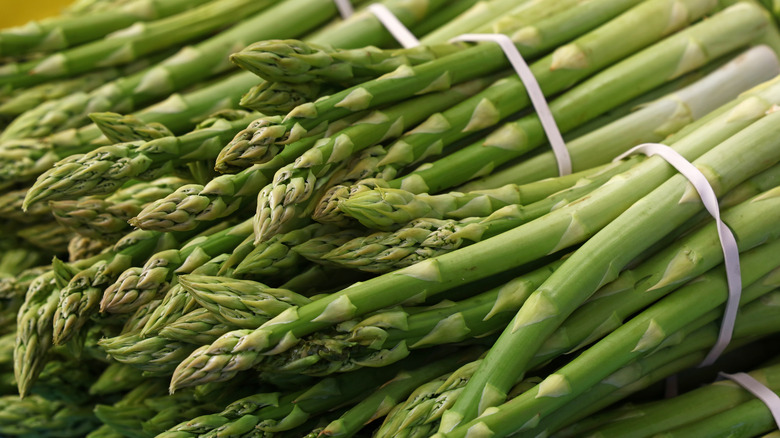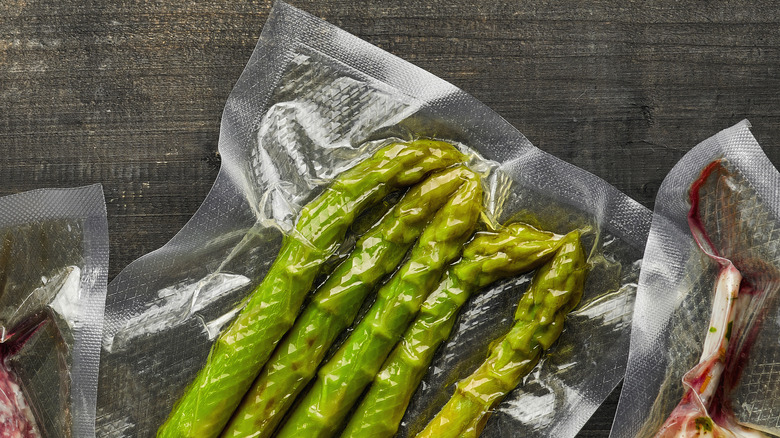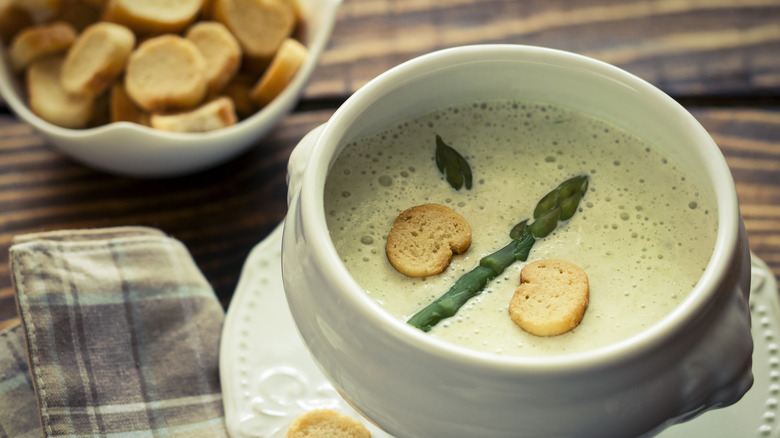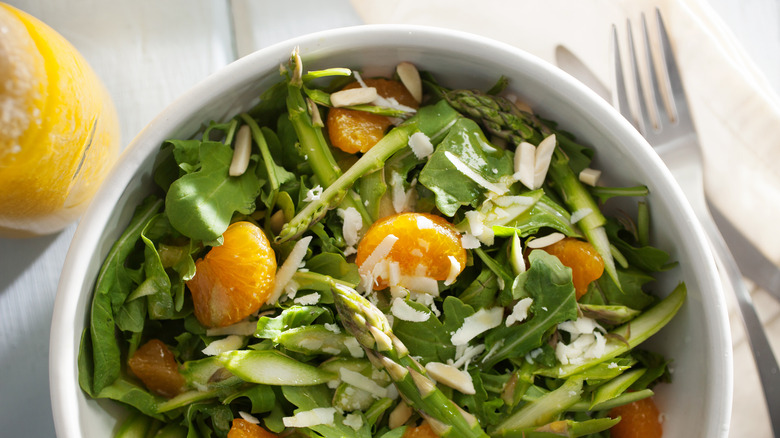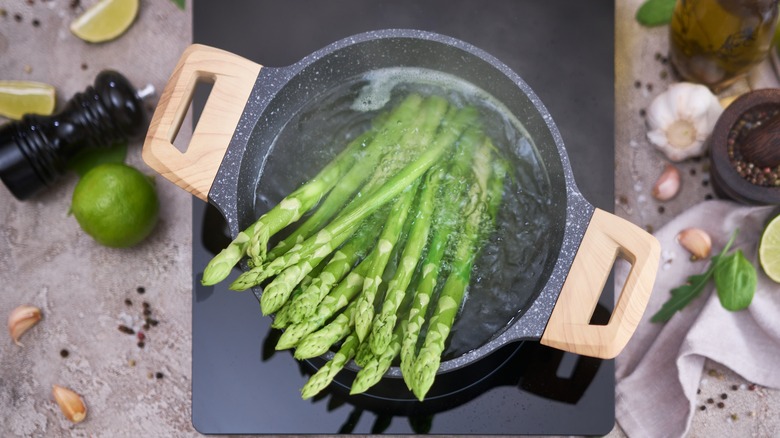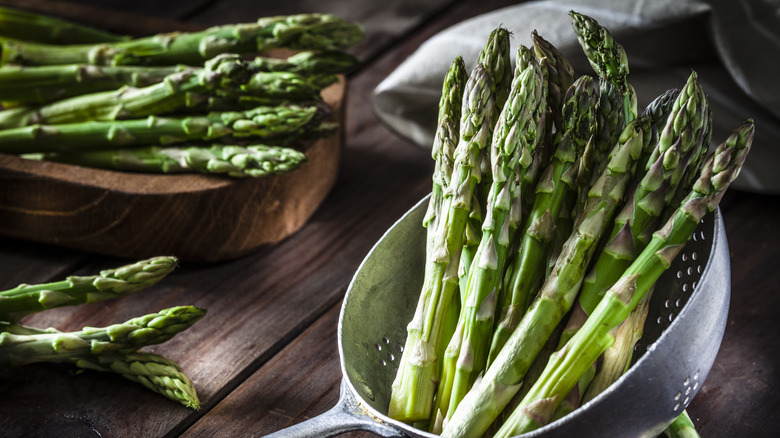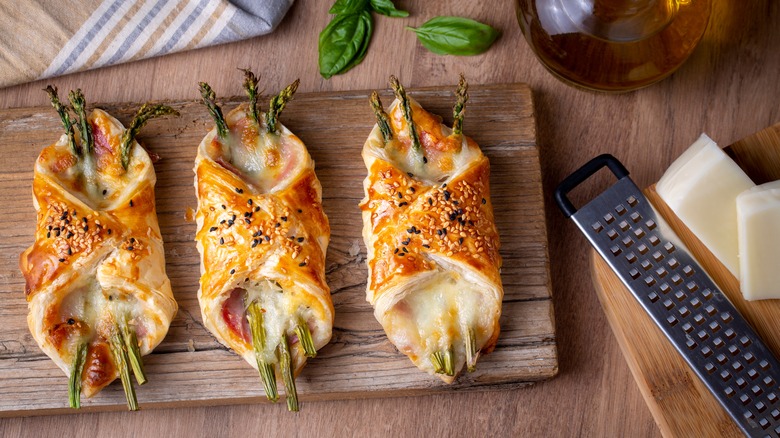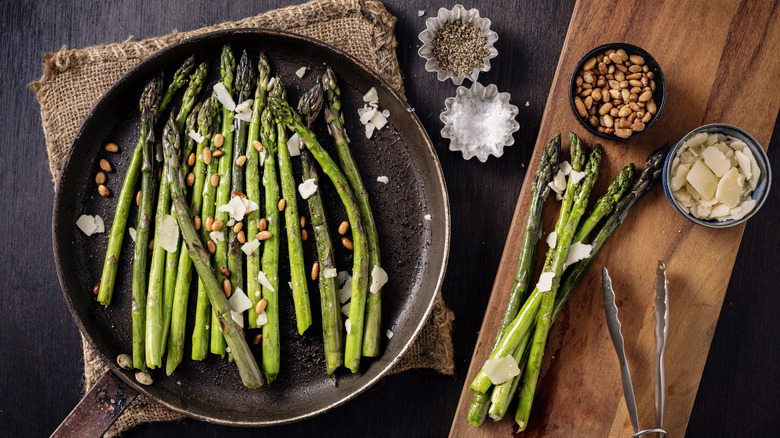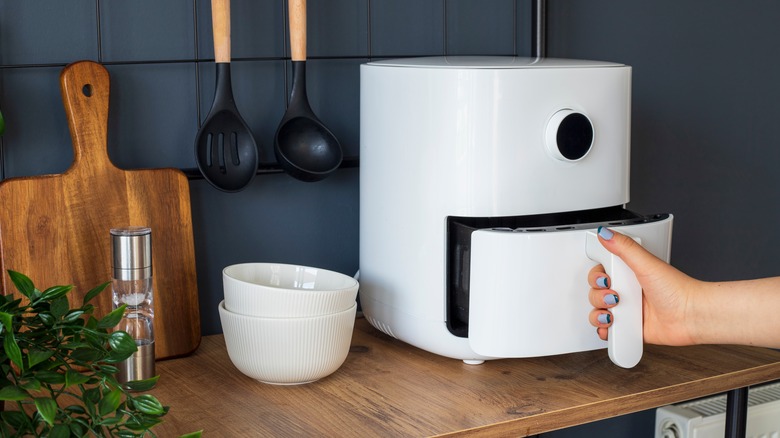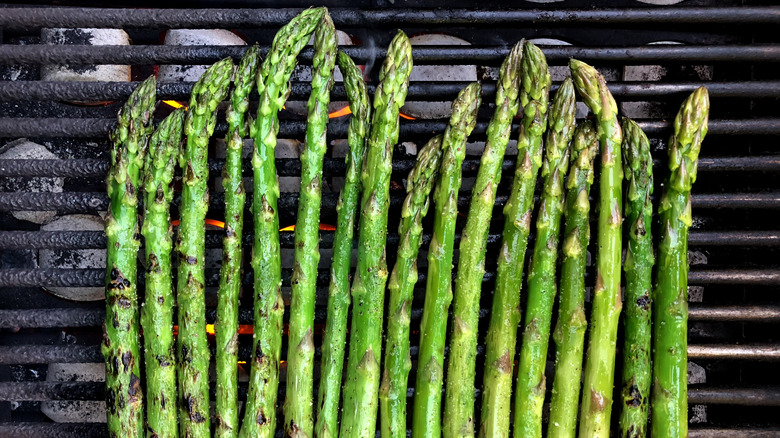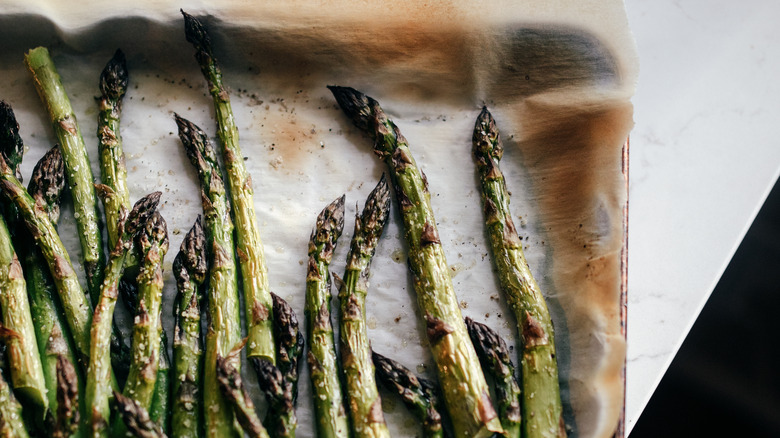10 Popular Ways To Cook Asparagus, Ranked
Asparagus is a seasonal favorite, each year signaling the arrival of spring as its verdant green spears emerge from the recently thawed land. It grows wild along river banks and has been enjoyed as a food source for thousands of years. Ancient Egyptians consumed asparagus, and it was cultivated in Macedonia as early as 200 B.C. Today, there are even white and purple cultivars available in grocery stores and farmers' markets around the world. It may be known as a springtime vegetable, but asparagus is adored year-round as a star ingredient in fresh pasta, silky soups, and satisfying side dishes.
Asparagus is a perennial crop that formerly belonged to the lily family, making it related to — but distinct from — alliums such as garlic and onions (which are also formerly classified as such). Nutritionally, asparagus is high in vitamins and minerals like vitamins A, C, E, K, and B6 and is an excellent source of iron, calcium, and fiber. Its flavor is the essence of spring, with grassy green bitterness against earthy sweetness, with slight woodsy notes. History and nutritional needs have given us many ways to cook asparagus. And while none of them are exactly bad, some methods are better than others.
10. Sous vide
In sous vide cooking, asparagus is sealed in airtight plastic and then submerged in temperature-controlled water to cook. The sous vide device precisely controls the water temperature and also circulates the water to ensure even cooking. There's nothing exactly wrong with sous vide asparagus, but there's nothing exceptionally right about it either.
It requires a sous vide cooker, a large container of water, and plastic to seal the container in — items that not everyone has. It's not particularly energy efficient, it's no faster than other methods, and it doesn't offer a significantly improved end result than boiling, steaming, or roasting. In fact, pull your tender asparagus from a sous vide bag and you may find that it actually needs the char or crisped edge that come with roasting. Sous vide asparagus is unnecessarily complicated and offers, at best, modest benefits over other cooking methods. It ranks last not because it's bad — it isn't — it's just not great either.
9. Asparagus puree
To create asparagus puree, the stalks are boiled until they are soft and then placed in a blender with some of the cooking water. Depending on the final use for the puree, it may be passed through a sieve or food mill to remove any small chunks for an even smoother end result. Asparagus puree is texturally heterogeneous so it usually needs to be paired with croutons, crackers, meat, or grain to give some texture variation and add visual and tactile interest.
Asparagus puree has a lot of uses. One of the most popular is cream of asparagus soup, which melds onion and garlic with the asparagus, broth, a squeeze of lemon to brighten things up, and cream to create a silky smooth texture. Asparagus puree can also act as an elegant base for a plate of perfectly seared scallops or finely plated steak, or you can blend it into a comforting asparagus risotto. You can even use asparagus puree as a sauce top roasted asparagus for a double dose of grassy goodness. The issue with these asparagus options is that each one is specific, which limits the versatility of a whole side vegetable..
You don't get to see the beautiful spear tips and the verdent color becomes somewhat subdued, so asparagus puree doesn't showcase the fresh vegetable as nicely as other cooking methods. It's also a bit labor-intensive for something that essentially leaves you with an ingredient rather than a finished dish.
8. Raw
Not a cooking method so much as a preparation method, asparagus can be eaten raw if it's properly prepared. Since there's no cooking heat to break down the plant's cell walls and soften it, raw asparagus needs a little help to make its fibrous stalks chewable and pleasant to eat. This can be accomplished by thinly shaving the raw stalks using a vegetable peeler or mandoline slicer. You can shave it vertically into long ribbons or at an angle for shorter rounds.
No longer woody and unyielding, sliced stalks become much more palatable, with a tender yet crunchy texture more like sliced carrots. Shaved raw asparagus can be substituted for cooked asparagus in salads or can serve as the base. The acidity of a light vinaigrette will help further break down the stalks while also providing a burst of zesty, complimentary flavor for the asparagus.
This no-cook cooking method retains all the nutritional goodness of the asparagus plant in its raw form, and it's a novel way to prepare asparagus if you're looking to switch things up. It also doesn't require turning on the oven so it's a great option for warm days when you need a no-cook meal. However, the flavor can be too strong for some people and others may not enjoy the crunch of raw veggies. Shaving the stalks can be a bit fussy and may require specialized equipment such as a mandoline slicer.
7. Boiled/blanched
This cooking method is as simple and straightforward as it gets. In the blanching method, asparagus is submerged in boiling water for a very brief period (less than 5 minutes) to soften the fibrous plant stalk and make it ready for eating. Unfortunately, some water-soluble vitamins and nutrients are lost during the blanching process. The longer the food is boiled, the more nutrients leach out.
As with most blanched vegetables, the timing is the most crucial factor. Since blanched asparagus is so uncomplicated, there's nothing to hide behind should you get it wrong. Too short a time in the water, and it will remain tough with an unpleasant, stalky texture. Too long, and it begins to get limp and mushy and darken from its normal bright hue. Blanching is extraordinarily easy, and also easy to mess up. The chief benefit of blanching asparagus is that it doesn't enhance or detract from the asparagus' natural flavor; you get asparagus in its unadulterated form: springy, firm, and vegetal. If you want anything to offset or alter the pure asparagus taste, you must instead rely on the flavors in the rest of the dish to enhance the grassy flavor.
You can really embrace the flavor of a wild spring forest by pairing asparagus with other seasonal delicacies like morel mushrooms as in this asparagus and morel risotto. In these examples, the plainness of blanched asparagus is a virtue; a blank slate upon which you can build the rest of the dish.
6. Steamed
Steaming asparagus is similar to blanched asparagus in a lot of ways. Steamed asparagus is cooked by the water vapor coming off the boiling water, a minor difference which gives it a slight edge over blanching because it's handy for small servings and for multitasking. You can steam asparagus above a pot of boiling potatoes, for example.
Since they are very similar, it's no shock that streamed asparagus has a lot of the same plusses and minuses as blanched asparagus. Like with the boiling method, the timing is crucial, and over-steamed asparagus comes out every bit as floppy, mushy, and sad as over-boiled stalks do.
Also as with boiling, very little is done during the cooking process that affects the flavor of steamed asparagus. This could be desirable if you plan to serve the asparagus with some of the asparagus's most well-known accompaniments such as soft-boiled eggs or rich buttery hollandaise sauce and you don't want to worry about competing or overpowering flavors. Soft-boiled eggs or hollandaise sauce will go with almost any type of cooked asparagus, though — what food isn't amazing with a runny yolk or decadent hollandaise? Steamed asparagus does have the advantage that you can fearlessly add a pungent umami flavor like anchovy butter or anchovy breadcrumbs to your egg and asparagus dishes. Like blanched asparagus, its strength lies in being another fairly blank slate cooking method that offers endless possibilities for how you use it.
5. Baked
For baked asparagus, fresh spears are trimmed and then chopped into bite-sized pieces, and then surrounded by an edible medium such as bread, pastry, or eggs, before it is placed in a hot oven and slowly baked via indirect heat. Baked asparagus is fairly foolproof because baked dishes have such long cook times, particularly when compared to blanched asparagus. The bread or eggs around the asparagus cause it to cook more slowly so the margin of error with baked asparagus is much bigger.
One of the most popular ways to bake asparagus is wrapped inside puff pastry, Golden brown, puff pastry-wrapped asparagus looks very impressive with almost no effort, so it's a perfect dish to serve to guests. To take it one step further, bake asparagus in puff pastry and then dip the pastry-wrapped spears in hollandaise — it's unbelievable!
Another common way to make baked asparagus is inside of eggs, in an asparagus frittata or quiche. Asparagus is a natural counterpart to eggs, and with the addition of herbs, seasonings, and a flaky crust, it makes an enticing, breezy brunch dish. It's also possible to use eggs and bread together and bake asparagus into a savory asparagus bread pudding with other seasonal produce, and mushrooms and alliums for flavor. Because of the array of combinations and near guarantee of even quality, baking asparagus is an excellent way to cook it. The downside, however, is the need for time and extensive preparation.
4. Sauteed
In the sautee method, trimmed asparagus is pan-fried in a small amount of fat — usually butter or olive oil — until it heats through and is soft enough to eat. This is an easy way to cook asparagus and it gives you the chance to infuse it with flavor during the cooking process, by sauteeing it with garlic, lemon, or other ingredients in the pan.
There are myriad ways to riff on this basic sauteed asparagus recipe. Some people use brown butter as the frying oil to add nutty complexity that perfectly plays off the earthy asparagus. Another common technique is to add a sprinkle of grated fresh parmesan atop the sauteed stalks. As a cooking method, sauteeing is fast, straightforward, and delivers a ton of flavor. It's perfect for cooking small amounts of asparagus or when you're in a bit of a hurry since asparagus sautees pretty quickly (in less than 10 minutes). It can be tough to manage large amounts of asparagus in a saucepan, though, so that's a limiting factor for this cooking method. It also doesn't get quite as pleasantly crispy as some of the top cooking methods. Still, sauteeing asparagus is a solid choice that won't let you down.
3. Air fried
Air fryers are all the rage of late. They're celebrated for their ability to create the same crispy crunch of fried food, without the deleterious effects of deep frying in oil. Despite the name, air fryers aren't actually frying foods at all — they are miniature convection ovens that produce crispy exteriors because of how they circulate air around food as it cooks. Nomenclature aside, air-fried foods are a healthy alternative to deep-fried foods. Deep-fried foods are almost always breaded or battered before frying to give a crisp outer shell. Since air frying is meant to mimic that effect, air fryer asparagus recipes call for the vegetables to be breaded before frying to create that desirable crunchy exterior. An egg or aquafaba wash acts as the glue to keep a coating of panko or breadcrumbs adhered to the outside. Dry seasonings like garlic powder or ranch powder add flavor without adding moisture that would prevent crisping.
Considering that air fryer asparagus is healthy, crispy, and flavorful, there aren't a ton of downsides to this cooking method. The only real drawbacks are that it requires a quality air fryer, and not everyone has access to one, and similar to sauteeing, it can be difficult to cook large quantities this way. Still, with a resources and attention, few cooking methods for asparagus offer such a highlight the vegetable.
2. Grilled
Grilled asparagus involves placing trimmed whole asparagus spears over a heat source and cooking them using direct heat. The asparagus is usually tossed with oil to keep it from sticking to the grill and to help it get a pleasant char on the outside and may be flavored with garlic, mustard, sweet sauces, or other seasonings. Some grilled asparagus recipes call for wrapping the individual spears in bacon or prosciutto for a kick of salty intensity.
Grilling is almost exclusively done outdoors and is synonymous with pleasant weather, so it's seasonally appropriate for a springtime yield of asparagus. Cooking asparagus over an open flame imparts a wonderful hint of smokiness to the vegetal asparagus flavor. Grilling asparagus is very simple, and grilled asparagus has more depth and complexity than sauteed or steamed versions. There are few real negatives to grilling as an asparagus cooking method. for starters, overcooking can result in a stringy, wilted vegetable without much flavor. The process requires a close eye (and nose) on the flames to make sure you're stalks don't lose too much mass. The other downside might be considered more trivial but, since it can be unpleasant to grill during bad weather, grilling asparagus really only appropriate at some times of the year.
1. Oven roasted
For oven roasted asparagus, the spears are tossed with a light coating of olive or other cooking oil, spread on a sheet pan, and cooked in the oven using indirect heat until tender. It's simple, it's expected, it's not groundbreaking or imaginative, it doesn't use any trendy gadgets, but roasted asparagus still reigns supreme as the best tried-and-true method for cooking asparagus for a reason; several reasons, in fact.
For one thing, roasting is a very forgiving cooking method. Oven roasting takes about 20 minutes so doesn't require the same precision and attention as blanching, for example. It's not laborious, either. Roasting only requires some chopping, tossing, and then waiting while the oven does the work. It reliably comes out with a perfectly crisp outside and a tender juicy interior. Unlike cooking methods that use water, roasting allows for the introduction of flavors during the cooking process. Lemon and garlic are traditional choices, but parmesan cheese, ranch flavoring, herbs, breadcrumbs, and spicy sauces are all outstanding on roasted asparagus. Roasted asparagus is extremely versatile. It's delicious right out of the oven as a side dish, or it can be used as an ingredient for any number of recipes. All in all, roasting asparagus is easy to do, hard to mess up, flavorful as it cooks, and versatile to use once it's done. It's a nearly perfect cooking method.
